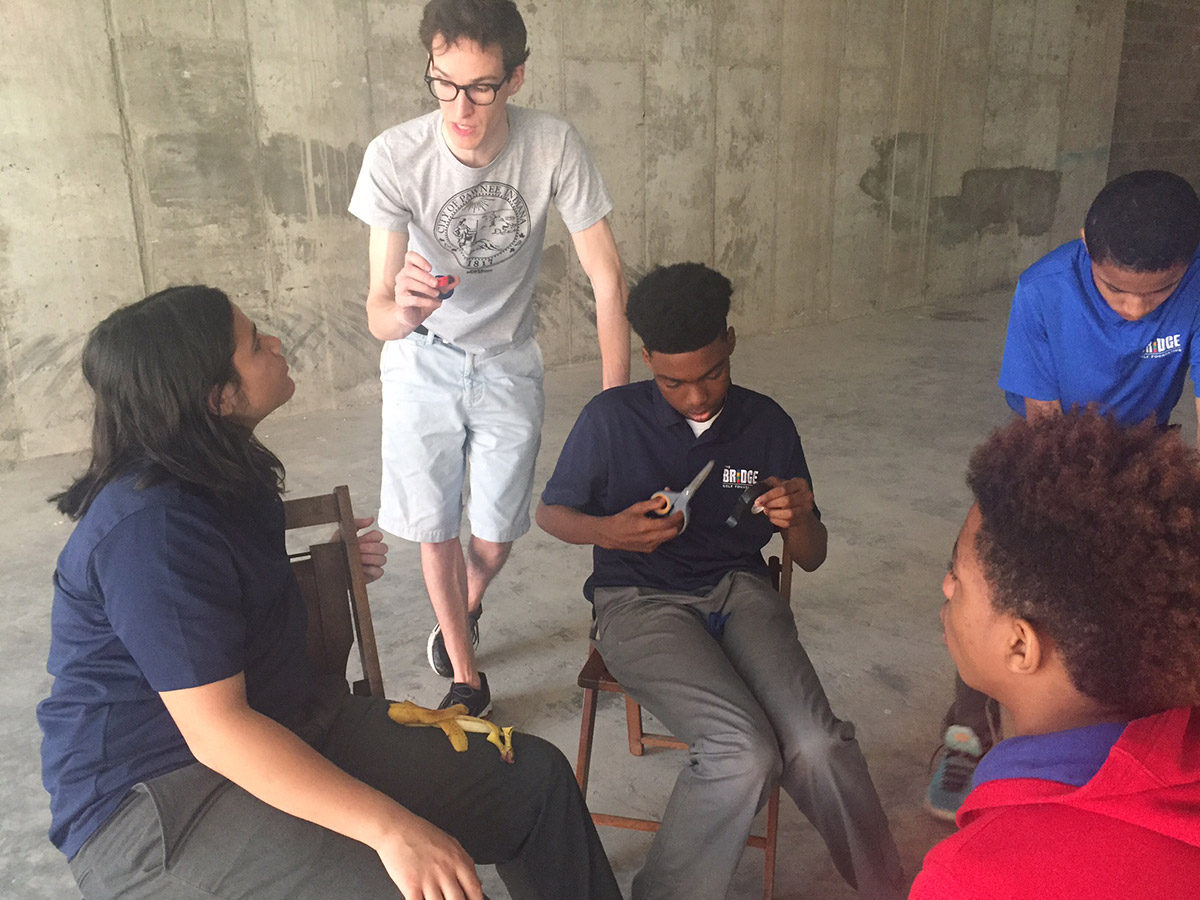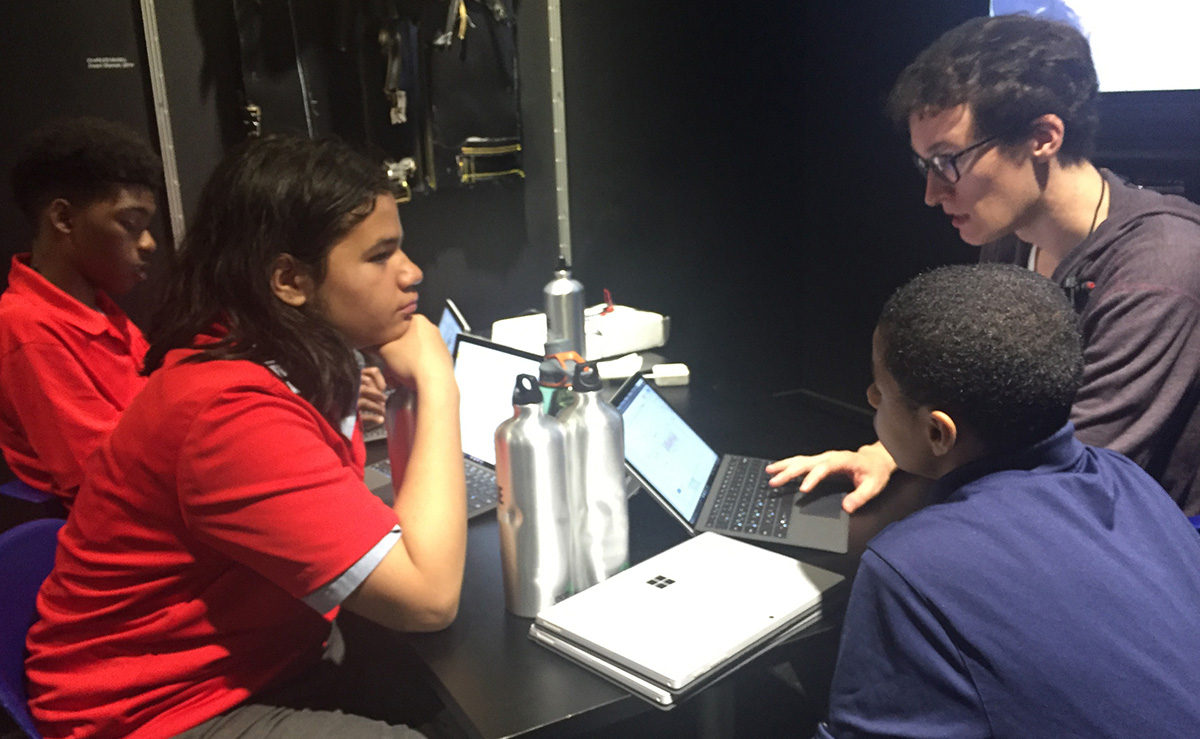
Charlie Cohen working with his group on their hydroelectric generator.
STEM Program Assistant Charlie Cohen recently fielded some questions from Executive Director and Co-Founder Farrell Evans.
As a STEM Program Assistant, what are your primary duties?
My primary role is to assist Veeshan Narinesingh, Herbert Brown and Tiffani Kolozian in the preparation and execution of their lessons. I also help to plan the curriculum and have written a few lessons myself. A large portion of the program is individual tutoring for homework and Regents Exam prep, so that also factors into my role. On Sundays, when I run a STEM Mini Lab for younger learners (age 4-8), I come up with my own lessons plans catered toward the interests of each student.
For the upcoming Water Fair, you led the young men in a project where they built a hydroelectric generator in a bucket. What’s the back and forth like between you and the young men through this process?
Working with four boys to build a do-it-yourself hydroelectric generator was a really interesting process, especially since the science behind it is all college-level physics. I’m really proud of the boys for learning and preparing as much as they did, and for coming as far as they did to build it. They’re jokers at heart, but when it was crunch time, they all put their pencils to the paper and got the work done.
You attended a New York City charter school and then went to City College for a physics degree. How did you develop a love for science?
I’ve almost always been in the New York City school system. I attended Summit, an inclusive charter school in Queens that goes from elementary through high school. I was a rather wild young man, and they really turned me around. My love for science really started in high school. My biology and earth science classes really opened my mind to how much science has changed our society. In biology, I fell in love with the method of scientific discovery, and its very real implications toward health and life. In earth science, my teacher had a habit of ending every lesson with doomsday scenarios. Initially that was terrifying, but it helped me to understand our planet’s history and how temporary our society really is.
 What led you first to The Bridge Golf Foundation, and what keeps you engaged and enthusiastic about our work?
What led you first to The Bridge Golf Foundation, and what keeps you engaged and enthusiastic about our work?
I was introduced to The Bridge by Veeshan and Matt Matzelle, both fellow graduates of the City College physics program. They told me about the opportunity to work closely with a small group of eager young scientists, helping to tutor, teach college physics and foster a love of science as these young men mature into adults. I was intrigued and joined the staff in August of 2016. Since then, the scope and the depth of our educational program have kept me adapting to the work.
When you’re not at the Learning Center, you work as a Research Assistant in the City College physics department. Please tell us about that work.
For the last two years, I have worked in Professor Vinod Menon’s Lab for Micro and Nano Photonics at City College. The work I’ve done there has been extremely engaging and rewarding. They took me straight from graduation and had me building microscopes, writing code, taking measurements and designing experiments. The lab’s primary focus is in laser optics, examining the nature of lab-grown, two-dimensional “metamaterials,” which are materials that have a variety of very interesting optical properties, are cheap, and can be custom-created to fit the scientist’s needs. The world is still understanding the scope of this field, and there’s a lot more work to be done in it.
My next step is to enter the field of aerospace engineering. My passion is to help humanity reach the stars, and with the advances in commercial aerospace, there are numerous opportunities for young engineers. So my goal is to attend a masters program studying rocket propulsion and designing new methods for interstellar space flight, basically pulling the wonders of science fiction into science reality.
What are you reading and why?
I’m always halfway through a number of books, probably because I enjoy exploring the world the author builds and how it applies to our own world more than I do actually finishing the story. I recently picked up Neil Gaiman’s “American Gods.” My favorite books are Michael Chabon’s “The Amazing Adventures of Kavalier & Clay,” Haruki Murakami’s “The Wind-Up Bird Chronicle,” and Frank Conroy’s “Body & Soul.” Books have the exciting capacity to elevate you from your reality and plunge you headfirst into the amazing.
You regularly bike around the city. What do you say to people who don’t wear helmets?
I find a lot of independence biking New York City. It frees me from cramped public transportation, and the guilt of car pollution, as well as letting me define the routes I take. It also elevates me above the height of the average pedestrian, giving me a new view of the city above the traffic. Not to mention the benefits of the regular cardio workout.
But it’s also incredibly dangerous. We live in a city where drivers can be very inconsiderate to pedestrians and cyclists. New York City cyclists have to be hyper aware of being doored or cut off. I’ve never been in a car collision, but I have fallen from my bike a few times. My helmet saved me. As a physicist, I can tell you that the fall from a bike can be devastating. Your head falls over six feet toward hard pavement, and you fall “weird.” Your instincts in that moment aren’t enough to protect your head. Living with helmet hair is better than not being alive.